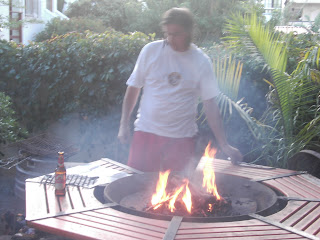
The man was also absent-mindedly waving an orange flag, and it was this which I noticed first. It is a long walk all the way up West Street towards Sheffield university, and at about 10.30am, and three weeks before Christmas, the pavement was extremely busy. I thought he was trying to flag down the overcrowded bus, amidst the throngs of people in the street. It was only when he came up to me and asked if he could give me an orange did I spare him a second thought.
I was also half asleep, and also in a hurry. I am one of those uncaring people who secretly hopes that the person walking along r e a l l y s l o w l y in front of you will soon fall down a manhole cover or something, I hate to admit it, but I don't often pay much attention to people around me. As such, being given an orange in the middle of the street by a bloke with a flag was a bit of a shock. So much so, in fact, that I just muttered "thank you", carried on going, and didn't even register the incident enough to ask WHY he was handing out oranges. It was only when, a little further up the road, another man stopped me with an orange that I worked out what was going on. The second bloke had the common sense to hand out flyers with his oranges. They were trying to raise awareness for a homelessness charity, based in Orange Street, Sheffield. Had I looked at what was in my hand, I would have noticed that each orange has a slip of paper with a website address on it. All very well and good, but not exactly immediately obvious to the semi-conscious commuter. To give them a helping hand, the charity has a blog here. Giving out oranges is innovative, and I am grateful for my unexpected vitamin shot this morning. I have a lot of respect for these people now.
However, the whole incident has got me pondering again. Such is the depth of my projects at the moment that I cannot experience isolated incidents without reading a great deal in to them, especially if they involve food. The orange has now interested me a great deal.
The advertising did work, eventually, in that I have now looked at their blog. Ben's Centre is a charity providing support and a safe environment for Sheffield's street drinkers. They are now based in Orange Street in Sheffield, and have seemingly adopted the orange as their logo. The fruit becomes a space, and with a bit of publicity, the space becomes a place. The space will become fruitful. The space also develops an identity of its own through its citrussy badge: a sanctuary - bright, colourful and cheerful, orange being a colour as well as a fruit. Healthy and healing- oranges are full of good vitamins and are great for dealing with hangovers. And given a community, an ideology and an identity of its own, the space has become a place.
(That, incidently, came from my own meanderings around the subject of oranges. I've just checked the "Ben's Logo" page on their site, and as it happens, I am spot on. That was exactly what they had intended to do with the logo. Which either means they are very clever or I have worked in the community/charity sector before. Both are true.)
But where did the orange come from? The website says... Tescos. Bah. I had been hoping for more than that somehow, although kudos to Tescos for donating said orange. There is no labeling on the orange apart from Ben's website. I have no way of telling where this orange originated. The chances are it was grown in some tropical but very poor country, and flown thousands of miles around the world, before getting scrubbed, waxed, weighed and regulated by Tesco's buyers, then chucked in a box and donated to the people on Orange Street around the corner. This orange is probably more well-travelled than I am, and is doing far more to help humanity than me. As such, I
 felt very guilty about eating it, I am not worthy!
felt very guilty about eating it, I am not worthy! There are a lot of tricky issues to do with the journey of this orange - environmental objections to the C02 emissions caused by flying oranges around the world, first world apologists who knowingly exploited third world orange growers and the inherent inequality of global capitalism. So far, so unoriginal. There is no connection with the orange farmer here, globalisation means that oranges are available ubiquitously, and unwittingly detaches us even further from thinking about what we really eat. The orange helps Ben's Centre create an imagined/constructed locality, but this is not the locality of the fruit's origin.
I for one have a keen interest in the Slow Food movement - which, in practical terms, means celebrating local and seasonal food, no forced, high yield crop growing. Slow, because you have to wait for the right season to get various different fruits or vegetables, negating the need to ship fruit around the globe. Celebrating home cooking too, none of the highly processed 'fast food'. Celebrating actually engaging with food again. If I followed this ideology to the letter, this would normally mean no oranges, especially not in December in Sheffield.
But in one sense at least, I have engaged with this orange, and that is in part to do with Ben's Centre. As well as raising awareness of a very worthy cause, they provided me with a welcome breakfast, and food for thought. It made me think about where I was and what I was doing, which in all seriousness, is a rarity. I like to think I do engage with the space known as Sheffield. I love this city, and I greatly enjoy my time here. Yet every time I am here, I rush up the hill at top speed, worrying about being late for meetings or lectures, generally with my head lowered, stooped under the weight of laptops and the enormous piles of academic papers I have so many good intentions of reading -later. I am usually in a bad mood, because my train has been nearly always late/cancelled/very very slow/overpriced. Sometimes I have headphones on, blotting out the world around me in favour of listening to Muse sing songs about the Knights of Cydonia or something equally obscure. Mentally and emotionally, I am not really in that space.
But really, why am I in such a rush? No-one at university is really going to mind if I am ten minutes later. Once on a train, I have absolutely no control over its speed, and there is no point in getting cross with it if I can't do anything about it. I ought to appreciate the time I have on trains, to appreciate the journey itself instead of impatiently awaiting the destination. I should take an interest in the city around me, the people that I nearly walk in to, for example, the charity workers who stand out with orange flags trying to gain your attention for long enough to give you an orange with a website on it. In the time it takes me to walk up the hill, there are half a dozen charity workers making breakfast for homeless people, my lecturers prepare their talks for that morning, my train heads on its way towards Plymouth, a Tescos employee stacks the fruit shelves in store, and no doubt, someone on the other side of the world starts picking oranges. As much as there is to be said for the Slow Food movement, perhaps there ought to be a drive towards a Slow Travel movement too, to encourage you to use you time wisely, to think of all the things happening simultaneously in the world, and to appreciated the created spaces around you. And to merrily suck on very social oranges.















